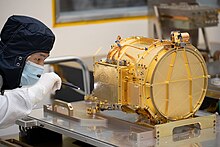
Cassini–Huygens, commonly called Cassini, was a space-research mission by NASA, the European Space Agency (ESA), and the Italian Space Agency (ASI) to send a space probe to study the planet Saturn and its system, including its rings and natural satellites. The Flagship-class robotic spacecraft comprised both NASA's Cassini space probe and ESA's Huygens lander, which landed on Saturn's largest moon, Titan. Cassini was the fourth space probe to visit Saturn and the first to enter its orbit, where it stayed from 2004 to 2017. The two craft took their names from the astronomers Giovanni Cassini and Christiaan Huygens.
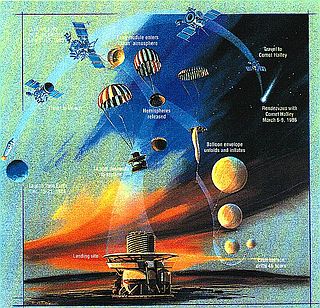
The Vega program was a series of Venus missions that also took advantage of the appearance of comet 1P/Halley in 1986. Vega 1 and Vega 2 were uncrewed spacecraft launched in a cooperative effort among the Soviet Union and Austria, Bulgaria, France, Hungary, the German Democratic Republic, Poland, Czechoslovakia, and the Federal Republic of Germany in December 1984. They had a two-part mission to investigate Venus and also flyby Halley's Comet.
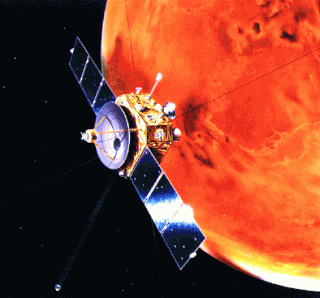
Nozomi was a Japanese Mars orbiter that failed to reach Mars due to electrical failure. It was constructed by the Institute of Space and Astronautical Science, University of Tokyo and launched on July 4, 1998, at 03:12 JST with an on-orbit dry mass of 258 kg and 282 kg of propellant. The Nozomi mission was terminated on December 31, 2003.

BepiColombo is a joint mission of the European Space Agency (ESA) and the Japan Aerospace Exploration Agency (JAXA) to the planet Mercury. The mission comprises two satellites launched together: the Mercury Planetary Orbiter (MPO) and Mio. The mission will perform a comprehensive study of Mercury, including characterization of its magnetic field, magnetosphere, and both interior and surface structure. It was launched on an Ariane 5 rocket on 20 October 2018 at 01:45 UTC, with an arrival at Mercury planned for on 5 December 2025, after a flyby of Earth, two flybys of Venus, and six flybys of Mercury. The mission was approved in November 2009, after years in proposal and planning as part of the European Space Agency's Horizon 2000+ programme; it is the last mission of the programme to be launched.

The Comet Rendezvous Asteroid Flyby (CRAF) was a cancelled plan for a NASA-led exploratory mission designed by the Jet Propulsion Laboratory during the mid-to-late 1980s and early 1990s, that planned to send a spacecraft to encounter an asteroid, and then to rendezvous with a comet and fly alongside it for nearly three years. The project was eventually canceled when it went over budget; most of the money still left was redirected to its twin spacecraft, Cassini–Huygens, destined for Saturn, so it could survive Congressional budget cutbacks. Most of CRAF's scientific objectives were later accomplished by the smaller NASA spacecraft Stardust and Deep Impact, and by ESA's flagship Rosetta mission.

Impact ionization is the process in a material by which one energetic charge carrier can lose energy by the creation of other charge carriers. For example, in semiconductors, an electron with enough kinetic energy can knock a bound electron out of its bound state and promote it to a state in the conduction band, creating an electron-hole pair. For carriers to have sufficient kinetic energy a sufficiently large electric field must be applied, in essence requiring a sufficiently large voltage but not necessarily a large current.

The Jupiter Icy Moons Explorer is an interplanetary spacecraft that was launched on 14 April 2023 from Guiana Space Centre in the French Guiana by the European Space Agency (ESA) with Airbus Defence and Space as the main contractor. The mission is planned to study Ganymede, Callisto, and Europa, three of Jupiter's Galilean moons. They are thought to have significant bodies of liquid water beneath their icy surfaces which would make them potentially habitable environments.
Eberhard Grün is a German planetary scientist who specialized in cosmic dust research. He is an active emeritus at the Max Planck Institute for Nuclear Physics (MPIK), Heidelberg (Germany), research associate at the Laboratory for Atmospheric and Space Physics (LASP) in Boulder (Colorado), and was a professor at the University of Heidelberg until his retirement in 2007. Eberhard Grün has had a leading role in international cosmic dust science for over 40 years.
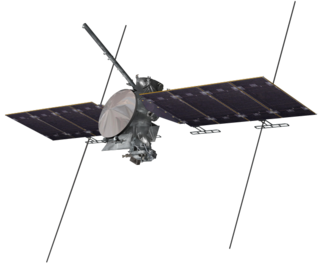
Europa Clipper is an interplanetary mission in development by NASA comprising an orbiter. Planned for launch in October 2024, the spacecraft is being developed to study the Galilean moon Europa through a series of flybys while in orbit around Jupiter.

Phobos And Deimos & Mars Environment (PADME) is a low-cost NASA Mars orbiter mission concept that would address longstanding unknowns about Mars' two moons Phobos and Deimos and their environment.
THEO is a feasibility study for a New Frontiers class orbiter mission to Enceladus that would directly sample its south pole water plumes in order to study its internal habitability and to search for biosignatures. Specifically, it would take advantage of the direct sampling opportunities of a subsurface ocean.

Explorer of Enceladus and Titan (E2T) is a space mission concept that would investigate the evolution and habitability of the Saturnian satellites Enceladus and Titan and is proposed by the European Space Agency in collaboration with NASA.
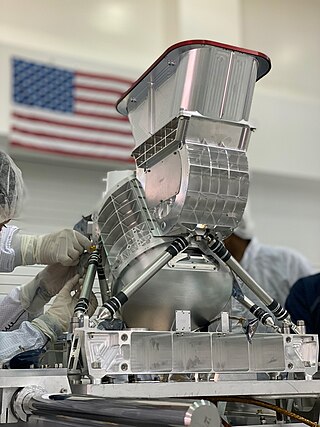
The Mapping Imaging Spectrometer for Europa (MISE) is an imaging near infrared spectrometer on board the Europa Clipper mission to Jupiter's moon Europa. MISE will examine Europa's surface composition and relate it to the habitability of its internal water ocean.
The Enceladus Icy Jet Analyzer (ENIJA) is a time-of-flight mass spectrometer developed to search for prebiotic molecules like amino acids and biosignatures in the plumes of Saturn's moon Enceladus.
Tianwen-4, formerly known as Gan De, is a planned interplanetary mission by China to study the Jovian system and its environs, sharing a launch with a spacecraft which will make a flyby of Uranus.

The Galileo and Ulysses Dust Detectors are almost identical dust instruments on the Galileo and Ulysses missions. The instruments are large-area highly reliable impact ionization detectors of sub-micron and micron sized dust particles. With these instruments the interplanetary dust cloud was characterized between Venus’ and Jupiter's orbits and over the solar poles. A stream of interstellar dust passing through the planetary system was discovered. Close to and inside the Jupiter system streams nanometer sized dust particles that were emitted from volcanoes on Jupiter's moon Io and ejecta clouds around the Galilean moons were discovered and characterized.
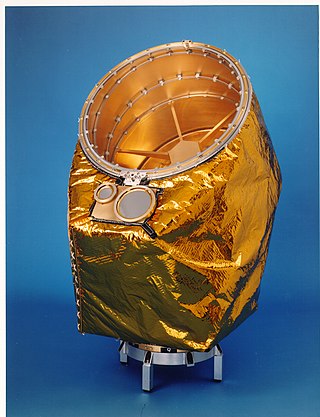
The Cosmic Dust Analyzer (CDA) on the Cassini mission is a large-area multi-sensor dust instrument that includes a chemical dust analyzer, a highly reliable impact ionization detector, and two high rate polarized polyvinylidene fluoride (PVDF) detectors. During 6 years en route to Saturn the CDA analysed the interplanetary dust cloud, the stream of interstellar dust, and Jupiter dust streams. During 13 years in orbit around Saturn the CDA studied the E ring, dust in the plumes of Enceladus, and dust in Saturn's environment.
Clementine 2 was a proposed asteroid-interception mission that was intended to fly by two near-Earth asteroids, 433 Eros and 4179 Toutatis planned by NASA.

Space dust measurement refers to the study of small particles of extraterrestrial material, known as micrometeoroids or interplanetary dust particles (IDPs), that are present in the Solar System. These particles are typically of micrometer to sub-millimeter size and are composed of a variety of materials including silicates, metals, and carbon compounds. The study of space dust is important as it provides insight into the composition and evolution of the Solar System, as well as the potential hazards posed by these particles to spacecraft and other space-borne assets. The measurement of space dust requires the use of advanced scientific techniques such as secondary ion mass spectrometry (SIMS), optical and atomic force microscopy (AFM), and laser-induced breakdown spectroscopy (LIBS) to accurately characterize the physical and chemical properties of these particles.
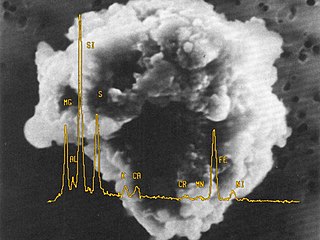
Dust astronomy is a subfield of astronomy that uses the information contained in individual cosmic dust particles ranging from their dynamical state to its isotopic, elemental, molecular, and mineralogical composition in order to obtain information on the astronomical objects occurring in outer space. Dust astronomy overlaps with the fields of Planetary science, Cosmochemistry, and Astrobiology.
